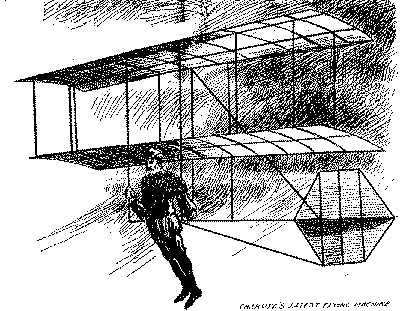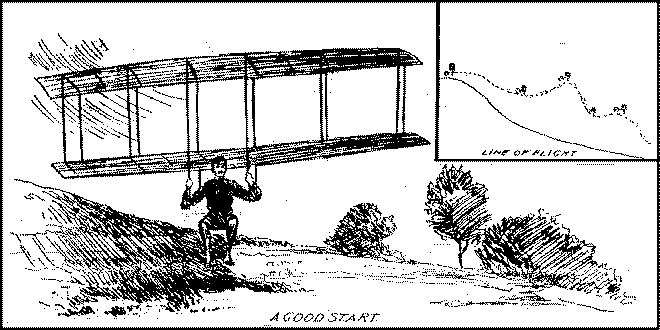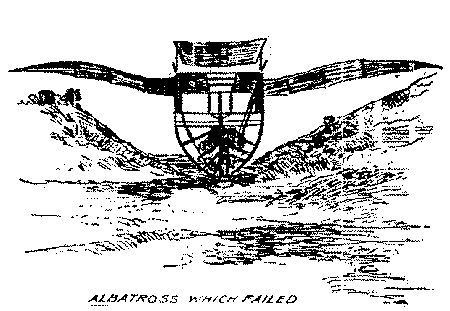The day is almost at hand when man will dispute with the bird for supremacy
in the air. For hundreds of years his ambition has been at work with such persistency
of effort that he now begins to see the end. He has grappled with the invisible
forces of the atmosphere, sometimes blindly but always courageously; generally to
meet with disappointment, but happily with enough success to keep alive his determination
to master the most difficult of all problems in physics. Lives have been lost and
fortunes have been expended in the pursuit of this baffling question of man-flight.
Ridicule has been heaped upon the heads of those who sought to cope with the feathered
messengers of the air, and their sanity questioned by the world at large.
Each success failure only served to strengthen the popular belief that the
problem of mechanical flight was beyond human understanding. The belief has grown
so universal that little or no attention has been paid to the wonderful progress
of recent years in this field of research and experiment. So marked has been the
advance in the last five years, however, that it is now the exception to find an
intelligent engineer who disputes the probability of the eventual solution of the
problem. Incredulity has given way, interest has been aroused in the scientific
side of the question, a sound basis has been furnished for experiment, and practical
results are being evolved by many workers which go to show that the end is not far
away.
The advance made toward the full solution of the problem of man-flight during
the year 1896 was greater than that of any previous year, and attracted the widest
attention, among scientists. Probably more interest centered in the experiments
conducted thirty miles southeast of Chicago on the shore of Lake Michigan by Octave
Chanute of this city than anywhere else. The prominent position occupied by Mr.
Chanute in the scientific world was accepted as a guarantee that he had faith in
his experiments, and that he had no other purpose in view but to demonstrate certain
principles involved in the problem.
Lines of Investigation.
At the time he was thus engaged Mr. Chanute observed much
caution in his utterance concerning the results obtained. Fearful lest his conclusions
might not be properly formed, or that he might be misunderstood, he refrained as
far as possible from committing himself on the subject further than to say his experiments
were very satisfactory. Since he has gained courage, so to speak, and has become
enthusiastic over what has been accomplished. He is now confident that the way is
clear for the solution of the problem, and modestly takes to himself a good share
of the credit for pointing the way. He claims that his experiment have marked out
the best lines for investigators to follow, and numbers them as follows in the order
of their importance:

1. The development of the self-propelled aeroplane.
2. The development of the motorless air sailer.
3. The development of the motor.
During the past week the experiments of last year have been renewed near Dune Park,
Ind. and Mr. Chanute has been an almost daily visitor to the scene of action. His
interest in the results will not let him stay away longer than one day for several
reasons. One reason is that the machine being used is one of his own invention in
its most important details, and another is that the experiments are following the
second line of investigation, which he laid down as necessary for the solution of
the problem of man-flight. It is said that Mr. Chanute is the real one who is conducting
the experiments, but this he denies in favor of A. M. Herring, a young man of considerable
scientific knowledge, who was associated with Mr. Chanute last year in his extensive
experiments at the same place.
Where and Why the Secrecy.
Those who have by casual reading formed the opinion that a few cranks had
hidden themselves among the sand hills at the foot of Lake Michigan for fear somebody
might steal the pattern of their airship have made a wide mistake and a natural
one. It is true that Mr. Herring wishes to avoid publicity as much as possible,
just as Mr. Chanute did last year. It is equally true that no better place could
be found a hundred miles around for conducting such experiments secretly. It is,
to all intents, miles away from civilization, and as desolate as the center of the
Sahara. The few fishermen who pass along the shore once in a while are generally
ignorant of the camp that has been established not more than 300 yards from the
beach.

All this secrecy, however, is only for the purpose of avoiding the curious-minded
and inquisitive visitors who would gather by thousands were the experiments conducted
openly. The fear that unscrupulous persons might appropriate the design of the machine
does not enter the minds of either Mr. Chanute or Mr. Herring. It has been fully
protected by patents, and the most minute descriptions of its construction have
been submitted to the readers of scientific publications. In fact, both gentlemen
are willing to supply all the information desired concerning the machine to those
who wish to build one for experimental purposes.
"My only object in taking out patents on the machine," Mr. Chanute says,
"is to prevent its use for commercial purposes. It was constructed solely for experimental
purposes, and in the interest of science. I have no objection whatever to its being
used in that way by anybody, but I would institute proceedings at once against anyone
who attempted to use the machine for exhibition purposes. I have had offers of financial
backing in unlimited amounts from men who thought the machine could be used in a
commercial way., and have refused the offers each time."
Same Class as Lilienthal's.
The machine with which Mr. Herring is now experimenting daily
represents the ideas of both himself and Mr. Chanute. It belongs to the same class
as the machine which the late Otto Lilienthal of Berlin brought out in 1894 and
in the use of which he met his death. It might well be termed a flying machine,
and yet this description does not fit accurately. It is technically known as an
aero-curve, or a gliding machine. Better still, it might be called an air coaster,
for in its action it approached very closely to the motion of those machines known
as roller coasters. The resemblances is carried still further in the application
of the principles of operation.
It is one of the three machines invented by Mr. Chanute, including
a steering apparatus designed by Mr. Herring. The first machine was based upon a
reverse of the principles evolved in the Lilienthal apparatus. Instead of the man
moving about under the machine to bring the center of gravity under the center of
air pressure, it was constructed with a view to bringing the center of pressure
over the center of gravity by the aid of wings moved automatically. This machine
had twelve wings, each six feet long and three feet wide, and each pivoted to a
central frame. It had a total wing surface of 177 square feet, and weighed thirty-seven
pounds.
By a process of evolution this apparatus became the machine in use
at the present time with which such remarkable results have been obtained. Experiments
showed many defects in the machine, and it was rebuilt on a different principle.
The twelve wings were discarded, and in their stead were substituted three superimposed
concave surfaces, each sixteen feet long and four feet wide, with an aggregate surface
of nineteen square feet. Attached to the rear of this machine was a combined horizontal
and vertical rudder, designed by Mr. Herring as a result of his frequent trials
of the machine. In the course of the experiments it was found necessary to remove
the lower surface, and this left the present machine.
Weight and Dimensions.
The several changes therefore reduced the sustaining surface
of the machine from 177 square feet to 135 square feet. The weight was lowered at
the same time from thirty-seven pounds to twenty-three pounds. This general reduction
did not impair the strength of the machine, while at the same time it improved its
efficiency to a remarkable degree. Repeated trials showed the machine capable of
sustaining an aggregate weight of 178 pounds, this figure representing the combined
weight of the operator and the machine. The frame is constructed of spruce wood,
braced with fine piano wire, and the concave surfaces are formed by varnished silk
stretched over the frame to the highest tension.
Will this machine fly? Mr. Chanute will answer this question by replying
that it was never intended to fly. He will inform those asking the question that
the machine is made for experimental purposes solely, with the end in view of developing
the motorless air sailer. At the same time, Mr. Chanute might say, the experiments
may lead to a solution of the most important part of the problem of man-flight -
the maintenance of the equilibrium of the machine under all circumstances. He holds
that this problem must be solved first. It has been demonstrated to his satisfaction
that until automatic stability at all angles of flight and conditions of wind is
evolved and safety thereby secured it would be premature to seek to apply a motor
or a propelling instrument to a full-sized machine.
The ordinary observer would answer that the machine does fly, nevertheless,
after witnessing a day's experiments among the sand dunes. The distinction between
sailing and gliding and flying would not appeal to any but the scientific mind while
watching the "double-decker" travel through the air a distance of 200 yards with
Mr. Herring hanging by his arms beneath. If the spectator was daring enough to tackle
the machine himself and succeeded in getting the right kind of a start he would
be willing to take oath that the machine flew. He would also be willing to testify
that his sensations while the flight lasted were indescribably thrilling and delightful.
Principle of Flight.
It is all very simple, this gliding through the air. If it
should ever happen that the machine is placed on the market it would soon develop
a new and very popular form of athletic sport beyond any doubt. The operator would
have to be nervy to a certain degree and in the full possession of his wits and
muscular powers. He might take a few falls at the beginning of his flights, but
a week's practice might prove him a skilled avatar. The experience of Mr. Herring
and William A. Avery during weeks of experiment showed that the machine offered
as safe a form of amusement as skating or riding the bicycle. Neither one received
as much as a scratch.

All the flights begin from an eminence, the numerous sand hills near
Dune Park offering all the opportunities desired for starting. Another requisite
is that the operator must start facing the wind, although with proficiency good
results may be obtained with the machine traveling at an angle with the wind. Those
who have seen a buzzard or most any other large bird begin a flight from the surface
of the earth will have noticed that the bird invariably faces the wind and runs
a few steps before rising. For the same reasons the operator of the Chanute flying
machine must face the wind, holding the machine over his head, then run a few steps
down the side of the hill on which he stands and finally give a jump outward into
space as though he never expected to come down. He will be doing nothing more, in
effect, than he did when he jumped from the top of a fence in boyhood days with
an umbrella over his head.
The wind rushing against the lower sides of the two surfaces of varnished
silk holds the operator suspended, while the angle at which he holds the surfaces
either impels it forward or retards its motion. Sometimes a strong gust of wind
comes along when least expected and suddenly raises the machine higher than the
starting point. But for the automatic rudder this might prove disastrous to the
operator. He would, in all likelihood, turn a back somersault with the machine and
get badly hurt. Again a blast of air might strike on the top of the machine and
cause it to shoot downward at a terrific rate of speed. This is what happened to
Lilienthal last year, and was the cause of the accident which resulted in his death.
The line of flight of the machine in the hands of a skillful operator
as Mr. Herring may be controlled very largely. He has demonstrated time and again
his ability to steer the machine in broad curves by simply shifting the weight of
his body from one side to another. Last Monday he succeeded in describing a compound
curve during a flight of about 300 feet, and ended with his back almost completely
turned to the wind. It has also been demonstrated that the machine can be made to
travel almost at right angles with the wind at a high rate of speed.
Flights have been made in all sorts of winds, the speed of which varied
from ten to thirty-one miles an hour. The latter wind is higher in its speed than
any gliding machine was ever tried in before and tested the steadiness of the machine
most thoroughly. The speed at which the machine travel rests very largely with the
operator and depends upon the angle of descent from the starting point. When he
finds that he is approaching the ground too swiftly it is only necessary for him
to tilt the front of the machine upward, when its speed will be immediately checked,
and a landing can be made safely. The range of flight is also very largely within
the control of the operator, one who is skillful being able to alight within ten
feet of any spot indicated while the wind maintains an even rate of speed. The longest
flight recorded is the one made this year by Mr. Herring, which was almost 500 feet.
Another flight of 600 feet was made last week.
Long flights are not the aim of the men conducting the experiments
with the gliding machines. They are seeking to arrive at intelligent conclusions
concerning the problem of automatic stability more than anything else, and it is
claimed by Mr. Chanute that many new facts have been discovered bearing upon this
question. In anticipation of an early solution of the question, Mr. Herring is hard
at work on a motor which he hopes to be able to apply to the gliding machine. An
evidence of the faith that is within him is shown by the fact that he predicts that
an air ship will be constructed within another year which will fly to New York with
but four stops on the way to replenish the stock of fuel.
"I seriously doubted at first whether automatic stability could be
secured with an artificial machine," said Mr. Chanute in speaking of the results
obtained by the experiments, "I doubted whether such combinations could be derived
for an inanimate apparatus as to perform the complicated functions of the life and
instincts of the birds which probably preserve their balance through almost unconscious
reflex action of their nerves and muscles. Observation has indicated to me," he
says, "that this might be automatic, requiring no thoughts under ordinary conditions,
and the final conclusion was reached that it might be possible to solve an artificial
apparatus which should afford automatic stability and safety most of the time, that
the variations of the winds were great difficulties to be encountered, that they
must be met and overcome, and that perhaps they might be utilized in obtaining pulsion
and support as is done daily by the soaring birds."
"I shall renew my experiments next year," concluded Mr. Chanute, "and
I believe that I will have a machine by that time which will be automatic in maintaining
its equilibrium. Then will be time enough to consider a motor. My experiments have
been made in the hope of gaining scientific knowledge and without expectation of
pecuniary profit. I believe the latter to be still afar off, for it seems unlikely
that a commercial machine will be perfected very soon. It will, in my judgment,
be worked out by a process of evolution: one experimenter finding his way a certain
distance into the labyrinth, the next penetrating further, and so on until the very
center is reached and success is won."